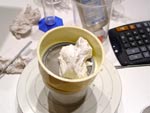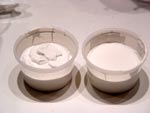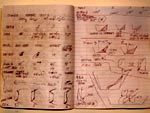|
Resolution of
Water Woes?
October 6, 2007 |
Zinc Silicate Crystalline Glaze Pottery
A chronicle of my recent
progress and a way for me to keep it straight in my head!
|
When I started making these
glazes in late December of this year I was using 20 megohm resistivity
de-ionized water at a rate of ~65 to 70% of the solids weight. I was ball
milling them, but found that not ball milling produced a glaze that was only
a little stiffer, but still usable. I also noticed that it didn't seem to
make a difference whether I used de-ionized water or tap water. I began
using tap water exclusively with no apparent problem and did so for months.
The tap water in my studio,
just like the water in my house and irrigation system (3 wells) comes from a
well drilled in limestone. The calcium carbonate level in the well serving
the house was 348 ppm (2 ppm below the state maximum) and will turn a shower
white in <2 weeks. We have had an extremely dry late summer and fall and
small ponds in the area have dried up, others have dropped up to 8 feet
below their normal level.
Things started to change
during late summer. I had to add more and more tap water to get the same
fluidity in the same glaze and even then it didn't brush out as well as I
remember. Eventually I was up to using it at a rate of 100% of the solids
weight in order to get even a paintable consistency. It looked like my glaze
was flocculated as I saw what I thought to be small flocs as it settled over
time. These things didn't seem to be
a problem until I noticed the glaze shrinking significantly on drying and
peeling off the pots on drying and falling off in chunks during firing..
Was it possible my water
was changing that much? How do I go about taking a look at the effect of my
available water types on the character of my glaze, without going to too
much trouble?
I decided to mix 100g
batches of my
8%
titania base (which seemed to be more problematic than others) with 70%
water from various sources.
 The
first sample mixed was with tap water. It seemed much like the consistency
that drove me to add more water in the first place. It was so thick it was
difficult to get through the 80 mesh sieve and I listed it as "Very Stiff"
in my notes.
The
first sample mixed was with tap water. It seemed much like the consistency
that drove me to add more water in the first place. It was so thick it was
difficult to get through the 80 mesh sieve and I listed it as "Very Stiff"
in my notes.
The second sample was using
a solution of 2 drops of Darvan 7 deflocculant per 1000ml of tap water. This
result in an improvement in the glaze, at least by the standards of my crude
eye. I listed it as "Stiff".
I mixed the third sample
using a solution of 10 drops of Darvan 7 deflocculant per 1000ml of tap
water. This resulted in the "Stiffest" mix yet.
Finally I prepared the
fourth batch using de-ionized water. This seemed to be the most fluid of the
group and I listed it as "Loose - bubbles coming up".
 There
was a dramatic difference appearance of the stiffest and least stiff of the
four preparations.
There
was a dramatic difference appearance of the stiffest and least stiff of the
four preparations.
I used a series of home
grown tests to characterize the rheology of these 4 glazes before sieving
including:
-
A "Tap Test" where I smoothed the glaze in the container so it existed on
one half of the container and counted the number of taps of the container on
the table need to get the glaze to flow across the bottom and touch the
opposite wall.
-
The "Ten Minute Angle" where I estimate the angle the glaze (which started
at ~45 degrees) assumed after sitting for 10 minutes.
-
The "Vertical Tap" test where I counted the number of taps of my finger
needed to get the glaze to flow vertically down and touch the opposite wall.
Additionally I characterized the shape of the gob when it touched.
-The "Fifteen Minute Shape" test where I observed the shape of the smoothed
glaze in the container after it sat for 15 minutes.
And then, after sieving,
the "Time to Edge" test where I rotated the container holding the sieved
glaze until the bottom was vertical and counted the seconds it took for the
glaze to flow down and touch the opposite wall.

At the end of the testing
there were noticeable visual differences in how the glazes appeared in their
containers. The numerical results of the various tests described above are
shown in my notebook.

The batch made using
batch using de-ionized water was the most fluid of the entire
group. The one made with 2 drops of Darvan 7 deflocculant per 1000ml of tap
water was the next most fluid.
As the "proof is in the
pudding" and this is all about glazing pots I combined batches 2 and 4
(with 1/2% cobalt carbonate and 2% manganese dioxide) then
did a first coat on 2 bowls. After drying this layer appeared to be stuck
tight to the piece. Then I combined batches 1 and 3 and did a second
coat. There was a minor amount of peeling, but nothing like I saw before.
Things I will probably try
in the future include using de-ionized water exclusively and possibly after
further investigation a) reduce the water content to less than 70% of the
batch, b) add additional CMC and c) add small amounts of Darvan 7 to
de-ionized water.
Dialogue with Anne Melvin
From: Phil Hamling
To: Anne Melvin
Subject: RE: Water
Anne,
Thanks for the quick feedback. All the ingredients are the same (same bag). I
have not been calcining the zinc. As far as pH goes my water typically is
around 7.4. I have not used distilled water. From a mineral content level
de-ionized is the same as distilled except it has not been treated for
bacteria.
Phil
-----Original Message-----
From: Anne Melvin
To: Phil Hamling
Subject: Water
Hi Phil,
Just a quick question about your "pudding" challenge.
Looking at your glaze recipe, did you buy new zinc? Or any other ingredient?
Are you calcining your zinc?
Otherwise, it seems the acidity of your glaze is causing it to floc or defloc
based on whether it's either acid or base.
Have you tried distilled water?
Just some thoughts.
Anne
Return to
Main Page
Phil Hamling
376
County Route 1
Warwick, NY, USA 10990

 The
first sample mixed was with tap water. It seemed much like the consistency
that drove me to add more water in the first place. It was so thick it was
difficult to get through the 80 mesh sieve and I listed it as "Very Stiff"
in my notes.
The
first sample mixed was with tap water. It seemed much like the consistency
that drove me to add more water in the first place. It was so thick it was
difficult to get through the 80 mesh sieve and I listed it as "Very Stiff"
in my notes.

